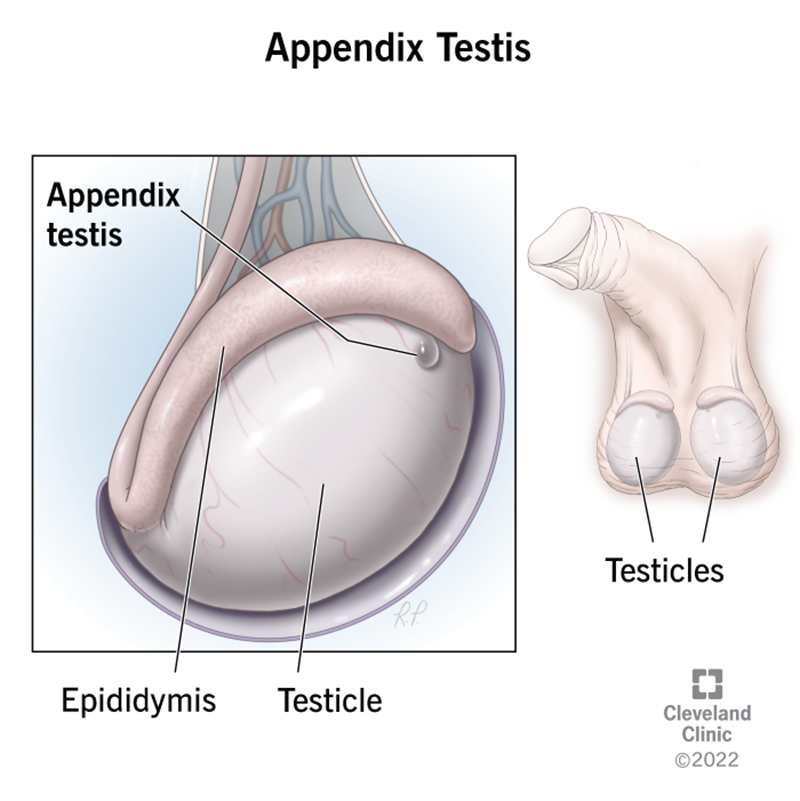An appendix testis is a normal but functionless piece of tissue that may be on one or both testes. The tissue is left over from a duct that’s part of an embryo’s development. It usually doesn’t cause any problems. But it may twist and cause sharp pain. Treatment usually includes rest, ice and pain medications.
Advertisement
Cleveland Clinic is a non-profit academic medical center. Advertising on our site helps support our mission. We do not endorse non-Cleveland Clinic products or services. Policy

The appendix testis (uh-PEN-diks TES-tis) is a small piece of tissue that may attach to the upper portion of one or both of your testicles (testes).
Advertisement
Cleveland Clinic is a non-profit academic medical center. Advertising on our site helps support our mission. We do not endorse non-Cleveland Clinic products or services. Policy
Most males have two testicles behind the penis. Your testicles are oval-shaped organs that produce male hormones and sperm. You may have an appendix testis on one or both testicles.
As an embryo develops into a fetus (fetal development), it has a Müllerian duct. In females, the duct develops into the female reproductive system. But in males, the duct doesn’t develop. The appendix testis is a remaining piece of the Müllerian duct — it’s a leftover part of something that previously existed and can’t function (vestigial remnant).
An appendix testis is a normal and common piece of tissue. More than 8 out of every 10 male children have it, and nearly 7 out of every 10 male children have it in both testicles (bilateral appendix testes).
Other names for the appendix testis include:
The appendix testis serves no purpose or function in males. It’s a leftover piece of Müllerian duct tissue from an embryo’s development. It usually isn’t problematic — most people don’t even know they have it.
In females, during fetal development, the Müllerian duct forms the:
The appendix testis is toward the top (upper pole) of your testicle. It connects to the tunica vaginalis. The tunica vaginalis is a type of serous membrane. Serous membranes are tissues that line the insides of your body cavities and wrap around your organs.
Advertisement
The appendix testis looks like a tiny fan or a small glob of tissue. But it’s under the pouch of skin that holds your testicles (scrotum), and you can’t see it under normal conditions.
Most people can’t feel an appendix testis at all unless it twists and causes pain. And if it twists and doesn’t receive enough blood, it may turn blue. You may be able to see a blue dot through your scrotum.
An appendix testis is small. It ranges from 1 to 7 millimeters long — about the size of a grain of sand to about half the size of an aspirin tablet.
An appendix testis is a piece of normal human tissue, so it’s not usually hard. But if it twists, it can become a hard, painful lump.
The only potential problem with the appendix testis is if it twists (torsion). Appendix testis torsion is a common cause of testicular pain, especially between the ages of 7 and 12. It can cause:
A healthcare provider can diagnose appendix testis torsion with a physical exam and an ultrasound.
Even though an appendix testis is small, your testicles have a lot of nerves, which make them very sensitive. Appendix testis torsion can feel like a sudden, sharp pain in your testicle. The pain may extend to your stomach. It may also make you feel like you’re going to vomit.
You don’t need treatment unless it twists. If a healthcare provider diagnoses you or your child with appendix testis torsion, treatment typically involves:
Swelling and pain usually go away in about a week.
In rare cases, a provider may recommend surgery to explore your scrotum. They may consider scrotal exploration if the diagnosis isn’t clear or if your pain:
It’s a type of cyst that affects females. It’s a remnant of the Müllerian ducts that attaches to one of the fimbriae in your ovaries by a stalk (peduncle).
Both the appendix testis and appendix epididymis are globs of tissue that you may have on your testicles. The appendix testis is the remnant of the Müllerian duct. But the appendix epididymis is a remnant of a different duct — the mesonephric ducts (Wolffian ducts). The mesonephric ducts eventually develop into organs in the male reproductive system, including the:
Advertisement
Testicular torsion occurs in the testicle itself, not the appendix testis. If you experience testicular torsion, the cord that provides blood flow to your testicle (spermatic cord) twists and cuts off the blood supply to your testicle.
Testicular torsion is a medical emergency that must receive immediate treatment.
Odds are, you probably don’t think about your appendix testis much. In fact, you might not know what an appendix testis is unless something is wrong. It’s a normal piece of tissue that commonly appears on one or both testicles. It doesn’t serve any purpose. But sometimes, it can twist and cause pain — usually in boys between the ages of 7 and 12.
Appendix testis pain usually goes away with rest, ice and some pain medications. But it’s always a good idea to see a healthcare provider if you or your child has sudden pain in a sensitive area.
Advertisement
If you have a condition that’s affecting your urinary system, you want expert advice. At Cleveland Clinic, we’ll work to create a treatment plan that’s right for you.

Last reviewed on 05/21/2025.
Learn more about the Health Library and our editorial process.